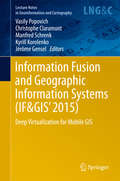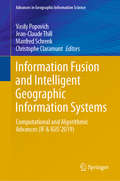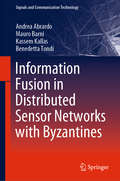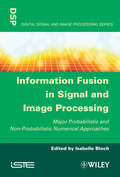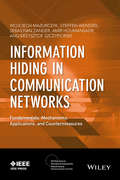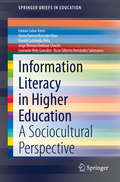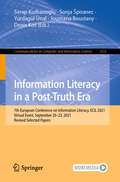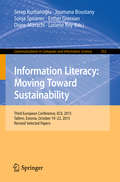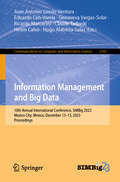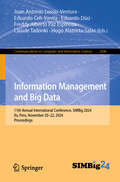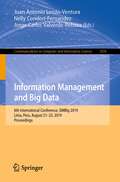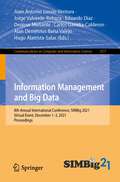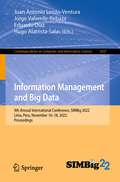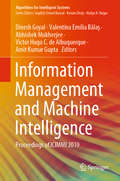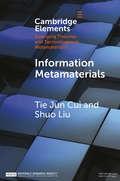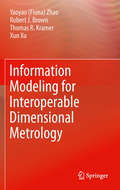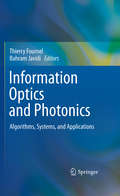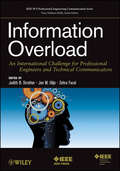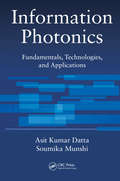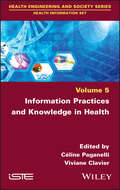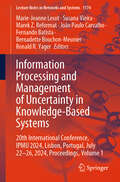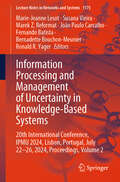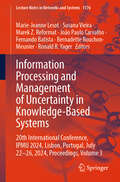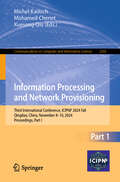- Table View
- List View
Information Fusion and Geographic Information Systems (IF&GIS' #2015)
by Vasily Popovich Christophe Claramunt Manfred Schrenk Kyrill Korolenko Jérôme GenselThese Workshop Proceedings reflect problems concerning advanced geo-information science with a special emphasis on deep virtualization for mobile GIS. They present papers from leading scientists engaged in research on environmental issues from a modeling, analysis, information processing and visualization perspective, as well as practitioners involved in GIS and GIS applications development. The proceedings examine in detail problems regarding scientific and technological innovations and deep virtualization for mobile GIS, its potential applications, and the monitoring, planning and simulation of urban systems with respect to economic trends as related to: Artificial intelligence; Knowledge-based GIS; Spatial ontologies in GIS; Positioning and analyzing moving information; Energy GIS; GIS data integration and modeling; Environmental management; Urban GIS; Transportation GIS; Underwater acoustics and GIS; GIS and real-time monitoring systems; GIS algorithms and computational issues; Data reliability and quality assurance for open data; Spatial and data quality; and lastly Open source GIS.
Information Fusion and Intelligent Geographic Information Systems: Computational and Algorithmic Advances (IF & IGIS’2019) (Advances in Geographic Information Science)
by Vasily Popovich Christophe Claramunt Manfred Schrenk Jean-Claude ThillThis book gathers the proceedings of the 9th International Symposium “Information Fusion and Intelligent Geographic Information Systems 2019” (IF&IGIS'2019), which was held in St. Petersburg, Russia from May 22 to 24, 2019. The goal of the symposium was to provide a forum for exchange among leading international scholars in the fields of spatial data, information integration and Intelligent Geographic Information Systems (IGIS). The symposium was an opportunity to discuss sound and effective lines of modeling in the fusion of spatial data and information within the broader scope of intelligent GIS. The topics of the 2019 Symposium essentially fall into three broad categories of developments aimed at leveraging the power of spatial information, namely: artificial intelligence; algorithmic and computations processes; and data-informed simulation models. All papers collected here present compelling, cutting-edge research on cloud computing, deep learning, visual analytics, and large-scale optimization. They discuss information fusion and intelligent GIS research in the context of surface and sub-surface maritime activities, port asset management, land-based trip and travel planning, smart city and e-government, emergency management, and environmental monitoring. Given its scope, the book will be of interest to students, researchers and professionals working in GIS, remote sensing, and cloud computing.
Information Fusion in Distributed Sensor Networks with Byzantines (Signals and Communication Technology)
by Andrea Abrardo Mauro Barni Kassem Kallas Benedetta TondiThis book reviews the most powerful attack strategies and potential defense mechanisms, always approaching the interplay between the Fusion Center and the Byzantines from a game-theoretic perspective. For each of the settings considered, the equilibria of the game and the corresponding payoffs are derived, shedding new light on the achievable performance level and the impact that the presence of the Byzantines has on the accuracy of decisions made by the Fusion Center. Accordingly, the book offers a simple yet effective introduction to the emerging field of adversarial information fusion, providing a wealth of intuitive take-home lessons for practitioners interested in applying the most basic notions to the design of practical systems, while at the same time introducing researchers and other readers to the mathematical details behind the theory.
Information Fusion in Signal and Image Processing: Major Probabilistic and Non-Probabilistic Numerical Approaches
by Isabelle BlochThe area of information fusion has grown considerably during the last few years, leading to a rapid and impressive evolution. In such fast-moving times, it is important to take stock of the changes that have occurred. As such, this books offers an overview of the general principles and specificities of information fusion in signal and image processing, as well as covering the main numerical methods (probabilistic approaches, fuzzy sets and possibility theory and belief functions).
Information Hiding in Communication Networks
by Krzysztof Szczypiorski Sebastian Zander Amir Houmansadr Steffen Wendzel Wojciech MazurczykDescribes Information Hiding in communication networks, and highlights their important issues, challenges, trends, and applications. Highlights development trends and potential future directions of Information Hiding Introduces a new classification and taxonomy for modern data hiding techniques Presents different types of network steganography mechanisms Introduces several example applications of information hiding in communication networks including some recent covert communication techniques in popular Internet services
Information Literacy in Higher Education: A Sociocultural Perspective (SpringerBriefs in Education)
by Fabiola Cabra-Torres Gloria Patricia Marciales Vivas Harold Castañeda-Peña Jorge Winston Barbosa-Chacón Leonardo Melo González Oscar Gilberto Hernández SalamancaThis book presents an innovative theoretical and methodological approach to study information literacy in higher education contexts. While mainstream studies tend to see information literacy as a technical and universal process, this book proposes a theoretical and methodological framework to study information literacy from a sociocultural perspective, highlighting the importance of the social and cultural contexts in which information literacy develops.This situated approach demands that research data must be analysed in relation to the contexts in which they emerge, so the book proposes a research method based on the study of personal histories and stories, learning situations and intersubjective relationships to characterize the different information profiles of different information users. Adopting a multidisciplinary approach that combines contributions from educational research, psychology and information sciences, the authors first present a theoretical discussion to argue in favor of the sociocultural paradigm to study information literacy, then present their methodological proposal to observe informational competencies among higher education students, and finally present the results of an empirical study to identify different information literacy profiles among Latin American students and teachers.Breaking with the hegemonic paradigm in the field, Information Literacy in Higher Education – A Sociocultural Perspective provides useful and innovative tools to researchers working in different areas of the social sciences, such as education, psychology, linguistics and information sciences.
Information Literacy in a Post-Truth Era: 7th European Conference on Information Literacy, ECIL 2021, Virtual Event, September 20–23, 2021, Revised Selected Papers (Communications in Computer and Information Science #1533)
by Serap Kurbanoğlu Joumana Boustany Sonja Špiranec Yurdagül Ünal Denis KosThis book constitutes the refereed post-conference proceedings of the 7th European Conference on Information Literacy, ECIL 2021, held in online mode in September 2021.The 61 revised papers included in this volume were carefully reviewed and selected from 192 submissions. The papers are organized in the topical sections on information literacy in a post-truth era and news literacy; health literacy; data literacy; digital literacy and digital empowerment; other literacies; information literacy in different contexts; information literacy education in different sectors; information literacy instruction; assessment and evaluation of information literacy; academic integrity, plagiarism and digital piracy; information behaviour; information literacy, libraries and librarians; information literacy in different cultures and countries; information literacy and democracy, citizenship, active participation.
Information Literacy: Third European Conference, ECIL 2015, Tallinn, Estonia, October 19-22, 2015, Revised Selected Papers (Communications in Computer and Information Science #552)
by Serap Kurbanoğlu Joumana Boustany Sonja Špiranec Esther Grassian Diane Mizrachi Loriene RoyThis book constitutes the refereed proceedings of the Third European Conference on Information Literacy, ECIL 2015, held in Tallinn, Estonia, in October 2015. The 61 revised full papers presented were carefully reviewed and selected from 226 submissions. The papers are organized in topical sections on information literacy, environment and sustainability; workplace information literacy and knowledge management; ICT competences and digital literacy; copyright literacy; other literacies; information literacy instruction; teaching and learning information literacy; information literacy, games and gamification; information need, information behavior and use; reading preference: print vs electronic; information literacy in higher education; scholarly competencies; information literacy, libraries and librarians; information literacy in different context.
Information Management and Big Data: 10th Annual International Conference, SIMBig 2023, Mexico City, Mexico, December 13–15, 2023, Proceedings (Communications in Computer and Information Science #2142)
by Juan Antonio Lossio-Ventura Hugo Alatrista-Salas Hiram Calvo Genoveva Vargas-Solar Eduardo Ceh-Varela Ricardo Marcacini Claude TadonkiThis book constitutes the refereed proceedings of the 10th Annual International Conference on Information Management and Big Data, SIMBig 2023, held in Mexico City, Mexico, during December 13–15, 2023. The 19 full papers and 6 short papers included in this book were carefully reviewed and selected from 64 submissions. SIMBig 2023 introduced innovative approaches for analyzing and handling datasets as well as new methods based on Artificial Intelligence (AI), Data Science, Machine Learning, Natural Language Processing, Semantic Web, Data-driven Software Engineering, Health Informatics, and more.
Information Management and Big Data: 11th Annual International Conference, SIMBig 2024, Ilo, Peru, November 20–22, 2024, Proceedings (Communications in Computer and Information Science #2496)
by Juan Antonio Lossio-Ventura Hugo Alatrista-Salas Eduardo Díaz Eduardo Ceh-Varela Claude Tadonki Freddy Paz EspinozaThis book constitutes the proceedings of the 11th Annual International Conference on Information Management and Big Data, SIMBig 2024, held in Ilo, Peru, during November 20–22, 2024. The 27 full papers and 1 short paper included in this book were carefully reviewed and selected from 102 submissions. They were organized in topical sections as follows: machine learning and deep learning; natural language processing; mining of social networks and online platforms; and signal and image processing.
Information Management and Big Data: 6th International Conference, SIMBig 2019, Lima, Peru, August 21–23, 2019, Proceedings (Communications in Computer and Information Science #1070)
by Juan Antonio Lossio-Ventura Nelly Condori-Fernandez Jorge Carlos Valverde-RebazaThis book constitutes the refereed proceedings of the 6th International Conference on Information Management and Big Data, SIMBig 2019, held in Lima, Peru, in August 2019.The 15 full papers and 16 short papers presented were carefully reviewed and selected from 104 submissions. The papers address issues such as data mining, artificial intelligence, Natural Language Processing, information retrieval, machine learning, web mining.
Information Management and Big Data: 8th Annual International Conference, SIMBig 2021, Virtual Event, December 1–3, 2021, Proceedings (Communications in Computer and Information Science #1577)
by Juan Antonio Lossio-Ventura Hugo Alatrista-Salas Denisse Muñante Eduardo Díaz Jorge Valverde-Rebaza Carlos Gavidia-Calderon Alan Demétrius Baria ValejoThis book constitutes the refereed proceedings of the 8th International Conference on Information Management and Big Data, SIMBig 2021, held as a virtual event in December 2021. The 25 revised full papers and 2 revised short papers presented were carefully reviewed and selected from 67 submissions. The papers are organized in topical sections on data mining and applications; deep learning and applications; data-driven software engineering; health, NLP, and social media; image processing, machine learning, and semantic web.
Information Management and Big Data: 9th Annual International Conference, SIMBig 2022, Lima, Peru, November 16–18, 2022, Proceedings (Communications in Computer and Information Science #1837)
by Juan Antonio Lossio-Ventura Hugo Alatrista-Salas Eduardo Díaz Jorge Valverde-RebazaThis book constitutes the refereed proceedings of the 9th Annual International Conference on Information Management and Big Data, SIMBig 2022, held in Lima, Peru, during November 16–18, 2022.The 18 full papers and 1 short paper included in this book were carefully reviewed and selected from 50 submissions. The volume presented novel methods for the analysis and management of large data, in fields like Artificial Intelligence (AI), Data Science, Machine Learning, Natural Language Processing, Semantic Web, Data-driven Software Engineering, Health Informatics.
Information Management and Machine Intelligence: Proceedings of ICIMMI 2019 (Algorithms for Intelligent Systems)
by Abhishek Mukherjee Amit Kumar Gupta Dinesh Goyal Valentina Emilia Bălaş Victor Hugo C. de AlbuquerqueThis book features selected papers presented at the International Conference on Information Management and Machine Intelligence (ICIMMI 2019), held at the Poornima Institute of Engineering & Technology, Jaipur, Rajasthan, India, on December 14–15, 2019. It covers a range of topics, including data analytics; AI; machine and deep learning; information management, security, processing techniques and interpretation; applications of artificial intelligence in soft computing and pattern recognition; cloud-based applications for machine learning; application of IoT in power distribution systems; as well as wireless sensor networks and adaptive wireless communication.
Information Measures for Hesitant Fuzzy Sets and Their Extensions (Uncertainty and Operations Research)
by Zeshui Xu Bahram FarhadiniaThis book gives a thorough and systematic introduction to the latest research results on hesitant fuzzy and its extensions decision making theory. It includes five chapters: Hesitant Fuzzy Set and its Extensions, Distance Measures for Hesitant Fuzzy Sets and Their Extensions, Similarity Measures for Hesitant Fuzzy Sets and Their Extensions, Entropy Measures for Hesitant Fuzzy Sets and Their Extensions, and Application of Information Measures in Multiple Criteria Decision Making. These methodologies are also implemented in various fields such as decision making, medical diagnosis, cluster analysis, environmental management, etc. This book is suitable for the engineers, technicians, and researchers in the fields of fuzzy mathematics, operations research, information science and management science and engineering, etc. It can also be used as a textbook for postgraduate and senior-year undergraduate students of the relevant professional institutions of higher learning.
Information Metamaterials (Elements in Emerging Theories and Technologies in Metamaterials)
by Tie Jun Cui Shuo LiuMetamaterials have attracted enormous interests from both physics and engineering communities in the past 20 years, owing to their powerful ability in manipulating electromagnetic waves. However, the functionalities of traditional metamaterials are fixed at the time of fabrication. To control the EM waves dynamically, active components are introduced to the meta-atoms, yielding active metamaterials. Recently, a special kind of active metamaterials, digital coding and programmable metamaterials, are proposed, which can achieve dynamically controllable functionalities using field programmable gate array (FPGA). Most importantly, the digital coding representations of metamaterials set up a bridge between the digital world and physical world, and allow metamaterials to process digital information directly, leading to information metamaterials. In this Element, we review the evolution of information metamaterials, mainly focusing on their basic concepts, design principles, fabrication techniques, experimental measurement and potential applications. Future developments of information metamaterials are also envisioned.
Information Modeling for Interoperable Dimensional Metrology
by Robert Brown Y Zhao T Kramer Xun XuDimensional metrology is an essential part of modern manufacturing technologies, but the basic theories and measurement methods are no longer sufficient for today's digitized systems. The information exchange between the software components of a dimensional metrology system not only costs a great deal of money, but also causes the entire system to lose data integrity. Information Modeling for Interoperable Dimensional Metrology analyzes interoperability issues in dimensional metrology systems and describes information modeling techniques. It discusses new approaches and data models for solving interoperability problems, as well as introducing process activities, existing and emerging data models, and the key technologies of dimensional metrology systems. Written for researchers in industry and academia, as well as advanced undergraduate and postgraduate students, this book gives both an overview and an in-depth understanding of complete dimensional metrology systems. By covering in detail the theory and main content, techniques, and methods used in dimensional metrology systems, Information Modeling for Interoperable Dimensional Metrology enables readers to solve real-world dimensional measurement problems in modern dimensional metrology practices.
Information Optics and Photonics
by Bahram Javidi Thierry FournelThis book will address the advances, applications, research results, and emerging areas of optics, photonics, computational approaches, nano-photonics, bio-photonics, with applications in information systems. The objectives are to bring together novel approaches, analysis, models, and technologies that enhance sensing, measurement, processing, interpretation, and visualization of information. The book will concentrate on new approaches to information systems, including integration of computational algorithms, bio-inspired models, photonics technologies, information security, bio-photonics, and nano-photonics. Applications include bio-photonics, digitally enhanced sensing and imaging systems, multi-dimensional optical imaging and image processing, bio-inspired imaging, 3D visualization, 3D displays, imaging on nano-scale, quantum optics, super resolution imaging, photonics for biological applications, microscopy, information optics, and holographic information systems.
Information Overload: An International Challenge for Professional Engineers and Technical Communicators
by Jan M. Ulijn Judith B. Strother Zohra FazalA unique approach to information overload, combining theory and practical solutions Written and edited by an international group of experts from academia and industry, Information Overload clearly links academic theory to real-world practice, providing a truly global and interdisciplinary treatment of this important topic. Emphasizing the role of engineers and technical communicators, the book discusses the root causes and costs of information overload within organizations and introduces strategies and proven techniques for reducing information overload and minimizing its negative impact. It offers a theoretical framework and ideas for future research, and features special chapter 'insight boxes' that recount different approaches to problems from various multinational corporations. Information Overload: Focuses on key definitions and challenges of information overload for both communicators and organizations Details a variety of technical and human-centered strategies for addressing the deluge of data Presents effective solutions tried at IBM, Xerox, and Harris Corporation Examines the effects of culture as well as that of color, visual form, text, and end-user documentation Offers an engineering perspective on the technologies available for dealing with information overload Information Overload also serves as a first-rate survival manual for researchers in academia, practicing engineers, technical communicators, and managers and professionals at all levels of profit and nonprofit organizations.
Information Photonics: Fundamentals, Technologies, and Applications
by Asit Kumar Datta Soumika MunshiThe main aim of this book is to introduce the concept of photonic information processing technologies to the graduate and post-graduate students, researchers, engineers and scientists. It is expected to give the readers an insight into the concepts of photonic techniques of processing as a system, the photonic devices as required components which are applied in the areas of communication, computation and intelligent pattern recognition.
Information Practices and Knowledge in Health
by Viviane Clavier Céline PaganelliIn the field of health, information practices and the organization of knowledge constitute a major challenge today. The practices of the medical profession, or of patients, are evolving under the influence of digital technology. At the same time, the way in which medical knowledge is organized, represented and mediated is also evolving.Information Practices and Knowledge in Health addresses the different aspects of the field of specialized medical and health information; it focuses on the informational practices of professionals in the sector, of patients and, more broadly, of citizens with regards to their health. This book also considers the systems that are used for organizing knowledge in this field.
Information Processing and Management of Uncertainty in Knowledge-Based Systems: 20th International Conference, IPMU 2024, Lisbon, Portugal, July 22-26, 2024, Proceedings, Volume 1 (Lecture Notes in Networks and Systems #1174)
by Ronald R. Yager Marek Z. Reformat Marie-Jeanne Lesot Susana Vieira Bernadette Bouchon-Meunier Fernando Batista João Paulo CarvalhoThis book is a collection of papers focused on techniques for managing uncertainty and aggregation. It provides a forum for exchanging ideas between theoreticians and practitioners in these and related areas. The papers are part of the 20th International Conference on Information Processing and Management of Uncertainty in Knowledge-Based Systems, which will occur in Lisbon, Portugal, from July 22 to 26, 2024. The collection describes the latest findings on topics such as advances in fuzzy systems and data analysis, optimization, scheduling via modeling uncertainty, explainability, decision-making, implications, data aggregation, and aggregation operators. A special chapter is dedicated to the memory of Michio Sugeno. The book is a valuable resource for practitioners, researchers, and graduate students who want to apply fuzzy-based techniques to real-world data analysis and management processes involving imprecision and uncertainty.
Information Processing and Management of Uncertainty in Knowledge-Based Systems: 20th International Conference, IPMU 2024, Lisbon, Portugal, July 22-26, 2024, Proceedings, Volume 2 (Lecture Notes in Networks and Systems #1175)
by Ronald R. Yager Marek Z. Reformat Marie-Jeanne Lesot Susana Vieira Bernadette Bouchon-Meunier Fernando Batista João Paulo CarvalhoThis book is a collection of papers focused on techniques for managing uncertainty and aggregation. It provides a forum for exchanging ideas between theoreticians and practitioners in these and related areas. The papers are part of the 20th International Conference on Information Processing and Management of Uncertainty in Knowledge-Based Systems, which will occur in Lisbon, Portugal, from July 22 to 26, 2024. The collection describes the latest findings on topics such as advances in fuzzy systems and data analysis, optimization, scheduling via modeling uncertainty, explainability, decision-making, implications, data aggregation, and aggregation operators. A special chapter is dedicated to the memory of Michio Sugeno. The book is a valuable resource for practitioners, researchers, and graduate students who want to apply fuzzy-based techniques to real-world data analysis and management processes involving imprecision and uncertainty.
Information Processing and Management of Uncertainty in Knowledge-Based Systems: 20th International Conference, IPMU 2024, Lisbon, Portugal, July 22-26, 2024, Proceedings, Volume 3 (Lecture Notes in Networks and Systems #1176)
by Ronald R. Yager Marek Z. Reformat Marie-Jeanne Lesot Susana Vieira Bernadette Bouchon-Meunier Fernando Batista João Paulo CarvalhoThis book is a collection of papers focused on techniques for managing uncertainty and aggregation. It provides a forum for exchanging ideas between theoreticians and practitioners in these and related areas. The papers are part of the 20th International Conference on Information Processing and Management of Uncertainty in Knowledge-Based Systems, which will occur in Lisbon, Portugal, from July 22 to 26, 2024. The collection describes the latest findings on topics such as advances in fuzzy systems and data analysis, optimization, scheduling via modeling uncertainty, explainability, decision-making, implications, data aggregation, and aggregation operators. A special chapter is dedicated to the memory of Michio Sugeno. The book is a valuable resource for practitioners, researchers, and graduate students who want to apply fuzzy-based techniques to real-world data analysis and management processes involving imprecision and uncertainty.
Information Processing and Network Provisioning: Third International Conference, ICIPNP 2024 Fall, Qingdao, China, November 8–10, 2024, Proceedings, Part I (Communications in Computer and Information Science #2593)
by Xuesong Qiu Michel Kadoch Mohamed CherietThe proceedings set CCIS 2593 until CCIS 2596 constitutes the proceedings of the Third International Conference on Information Processing and Network Provisioning, ICIPNP 2024, which took place in Qingdao, China, during November 8-10, 2024. The 153 full papers presented in the proceedings were carefully reviewed and selected from 277 submissions. They deal with up to date research ranging from information and signal processing and network provisioning to computer communications and network applications.
